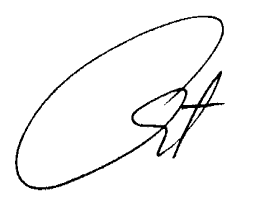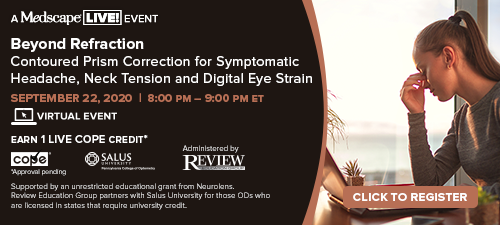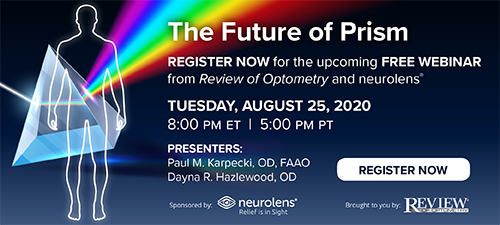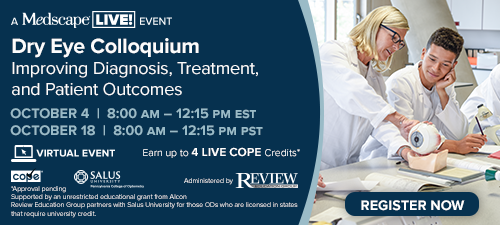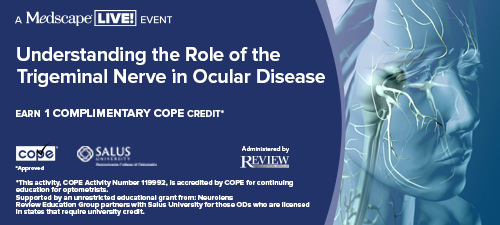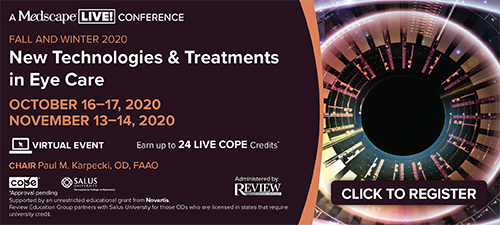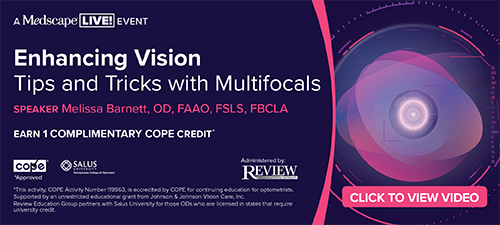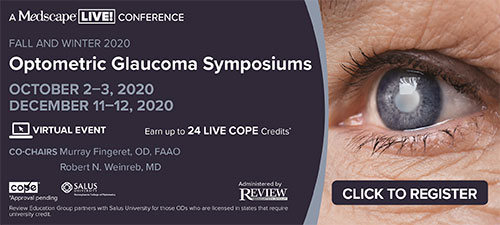
A
weekly e-journal by Art Epstein, OD, FAAO
Off the Cuff: Crazy Days During a Crazy Time
By now, those waiting for the arrival of that new normal that everyone was talking about have probably realized that there isn’t going to be any new normal. The truth is that nothing is normal, nor likely to be anytime soon. My life is a perfect example. With no travel, I am seeing patients more than I have in recent years. While there is comfort in being in the office more, caring for patients in need and falling into a familiar routine, it’s not always that comfortable or, for that matter, routine. I can best describe it as being on an emotional and clinical rollercoaster, with some days a wilder ride than others. We’re busy, and I am thankful for that, but many of our patients—even ones we’ve been treating for years are stressed and on edge. The level of complexity of patients we’re seeing has also changed, transforming from what I affectionally called the “the cradle of misery in Phoenix, Arizona” into cases you would expect to see in a tertiary specialty clinic at a major university hospital. The past few weeks, our young associate Cory Lappin diagnosed a patient with Wyburn-Mason syndrome—the first case I’ve ever seen. Shannon had a patient with silent sinus syndrome—look that one up—and I’ve had a gaggle of neurotrophic keratitis cases including a dry eye patient who rapidly decompensated to an 8mm central corneal melt that I thankfully was able to manage back from the edge of a tarsorrhaphy. Thank you Oxervate! That was just a taste of what we’re dealing with clinically. Our patients are also more emotionally challenging, often taking matters into their own hands. A few weeks back I saw a patient who was so convinced that she had Demodex and that she could feel the mites crawling on her eyelids that she purchased a USB microscope, epilated several lashes and came to her first visit with videos of her own Demodex. That was a first for me. Another patient grew impatient after dry eye testing and wanted to leave. She told my tech that I could look at the images and prescribe something for her. She didn’t think it was necessary for me to see her or for her to know what actually was wrong with her. I insisted and did see her, and there was more wrong with her than just her eyes. We have recommended patients seek counseling more over the past two months than I have over the past 20 years. I know some of you are thinking that this is that new normal and that this craziness is here to stay, but I refuse to accept that. Human nature is to prevail over adversity. COVID, like other infectious diseases, will either pass, be effectively managed or fade into the background of our normal lives. I even suspect in years to come we will look back on this pandemic and see good that came out of it. I pray that will happen sooner rather than later.
|
|||||
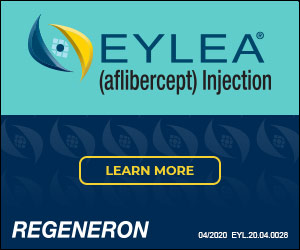 |
||
| Duration of Contact Lens Removal Before Myopic Refractive Surgery | ||||
To compare refractive surgery outcomes in patients with different periods without contact lenses prior laser surgery, subjects who underwent myopic keratorefractive laser surgery between January 2005 and December 2014 were divided into three groups based on the duration of time passed free of soft contact lens wearing prior to final preoperative evaluation and surgery (<24 hours, one to three days or >three days). Spectacle wearers served as a control group. Postoperative safety index, efficacy index and percent of eyes within 0.5D of the four groups were compared. A general linear model was used to compare main outcomes while adjusting for age, gender, preoperative measurements and procedure type (LASIK vs PRK). Overall, 19,747 eyes were included. Soft contact lenses were worn by 42.3% (<24 hours: 4.8%, one to three days: 18.5% and >three days: 19%) and spectacles by 57.7% prior to surgery. In the PRK group, after adjusting for differences in baseline variables, the <24-hour group had a significantly lower efficacy index than all the other groups. There were no significant differences between groups in terms of percent of eyes within ±0.5D of intended correction or safety index. In the LASIK group, after adjusting for differences in baseline variables, no significant differences were found between groups in all primary outcomes. |
||||
SOURCE: Shehadeh-Mashor R, Mimouni M, Shapira Y, et al. Duration of contact lens removal before myopic refractive surgery. Eur J Ophthalmol. 2020; Aug 18. [Epub ahead of print]. |
||||
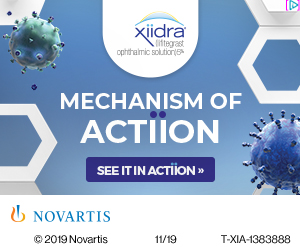 |
||
| Seasonal Variation of Intraocular Pressure in Glaucoma With and Without Dry Eye | ||||
The management of intraocular pressure (IOP) is important for glaucoma treatment. IOP is recognized for showing seasonal fluctuation. Glaucoma patients can be at high risk of dry eye disease (DED). As such, investigators evaluated seasonal variation of IOP with and without DED in glaucoma patients. This study enrolled 4,708 patients, with a mean age of 55.2 years, who visited a clinic in Japan from March 2015 to February 2017. Investigators compared the seasonal variation in IOP (mean ± SD) across spring (March to May), summer (June to August), fall (September to November) and winter (December to February). IOP was highest in winter and lowest in summer, at 14.2/13.7 for non-glaucoma without DED group (n=2,853, p=0.001), 14.5/13.6 for non-glaucoma with DED group (n=1,500, p=0.000), 14/13 for glaucoma without DED group (n=240, p=0.051) and 15.4/12.4 for glaucoma with DED group (n=115, p=0.015). Seasonal variation was largest across the seasons in the glaucoma with DED group. IOP was also inversely correlated with corneal staining score. Investigators concluded that the seasonal variation was significant in most study groups and IOP may tend to be low in summer.
|
||||
SOURCE: Kuze M, Ayaki M, Yuki K, et al. Seasonal variation of intra-ocular pressure in glaucoma with and without dry eye. Sci Rep. 2020;10(1):13949. |
||||
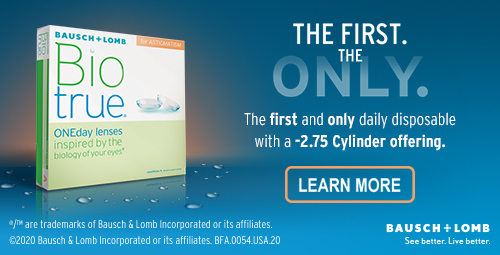 |
||
| Association Between Conjunctival Goblet Cells and Corneal Resident Dendritic Cell Density Changes in New Contact Lens Wearers | ||||
Contact lens comfort is influenced by a smooth transition of changes to the ocular surface epithelium, including cellular density. Conjunctival goblet cells are known to suppress activation of dendritic cells and therefore prevent inflammatory response. Hence, monitoring goblet cell numbers during lens adaptation could potentially facilitate comfortable lens wear. To explore the interlink between conjunctival goblet and corneal dendritic cell density after six months of lens wear and to predict dendritic cell migration to the central cornea based on goblet cell loss in the conjunctiva as a response to contact lens wear, 69 subjects who had never previously worn contact lenses were observed for six months; 46 were fitted with contact lenses and 21 served as a control group. Corneal confocal microscopy was used to quantify goblet and dendritic cell density before and after six months of daily lens wear. Symptomatic and asymptomatic groups were identified in the lens-wearing group using a combination of signs and symptoms present. Pearson's correlation was used to determine associations between the total change of cell densities after six months of lens wear. At baseline, there was no association between conjunctival goblet and corneal dendritic cell density. After six months, there was an inverse association between the absolute change of conjunctival goblet and corneal dendritic cell density in all participants (n=69). Dendritic cell density in the central cornea was increased by 1.5 cells/mm2 for every decrease of 1 goblet cell/mm2 in the conjunctiva. Researchers wrote, after six months of wear, contact lens-induced goblet cell loss can partially predict resident corneal dendritic cell migration to the central cornea (observed as an increase in dendritic cell density). They added that the association between total cell density change after six months was established in wearers regardless of lens symptomatology, suggesting that cell density changes as a physiological adaptation to regulate the effect of contact lens wear on the ocular surface. |
||||
SOURCE: Colorado LH, Pritchard N, Alzahrani Y, et al. Association between conjunctival goblet cells and corneal resident dendritic cell density changes in new contact lens wearers. Clin Exp Optom. 2020; Aug 18. Epub ahead of print]. |
||||
| News & Notes | ||||||||
| AAOF Announces Alfred A. Rosenbloom, Jr., Low Vision Residency Award & Hopkins Comprehensive Eye Care Award Recipients The American Academy of Optometry Foundation announced Carolyn N. Chakuroff, OD, MS, is this year’s recipient of the Alfred A. Rosenbloom, Jr., Low Vision Residency Award. Dr. Chakuroff is a graduate of The Ohio State University College of Optometry and an Ocular Disease/Low Vision Rehabilitation resident at the Kansas City VA Medical Center. Read more. The AAOF also announced Charlotte Yiyi Wang, OD is this year’s recipient of the Hopkins Comprehensive Eye Care Award. Dr. Wang is a graduate of the University of California, Berkeley School of Optometry, and primary care/community health resident at the Meredith W. Morgan University Eye Center. Read more. |
||||||||
|
||||||||
| B+L Launches Infuse Sihy Daily Disposable Contact Lenses Bausch + Lomb launched Infuse silicone hydrogel (SiHy). The daily disposable contact lens featuring a next-generation SiHy daily disposable lens material (kalifilcon A) and ProBalance Technology that work together to help maintain ocular surface homeostasis to help reduce contact lens dryness and discomfort. The ProBalance Technology formula includes the osmoprotectants erythritol and glycerin and the electrolyte potassium, inspired by findings from the Tear Film and Ocular Surface Society DEWS II report. The ProBalance Technology formula also includes two moisturizers to help retain hydration; provide a smooth, wettable surface; and maintain tear proteins in a healthy state. Learn more. |
||||||||
|
||||||||
| J&J Vision Offers New Acuvue Services & Resources as Part of Contact Lens Health Week Johnson & Johnson Vision announced the availability of tools and resources for eye care practitioners to enhance the contact lens experience, in conjunction with Contact Lens Health Week. The company is a supporter of Contact Lens Health Week, sponsored by the Centers for Disease Control and Prevention. The resources include: • Acuvue LensAssist: A virtual training platform that promotes hygienic contact lens use, now with new enhancements including free live support and on-demand assistance. • The Acuvue Eye Care Provider Locator: Allows patients to connect with eye care practitioners using the “Find a Doctor” map on Acuvue.com. • Acuvue Digital Fit Calculator: Helps eye care practitioners provide an efficient, accurate and comfortable lens fitting for patients with astigmatism and those who require a multifocal contact lens. • Acuvue Rewards: Now offers added savings across the entire Acuvue portfolio. Learn more. |
||||||||
|
||||||||
| Alcon Kicks Off Global Social Media Campaign to Support Eye Care Practices Alcon kicked off a global social media campaign, “Reasons to Love Lenses,” during Contact Lens Health Week, Aug. 17 to 21, 2020. The new campaign raises consumer awareness of the benefits of contact lens wear and reiterates the value of prescribing contact lenses for eye care professionals, encouraging consumers to visit eye care practices re-opening after the COVID-19 pandemic. The campaign will roll out globally on Alcon’s social media platforms. The company also recently conducted a survey on the impact of the COVID-19 pandemic on contact lens usage and care. The survey, conducted by research firm MarketVision, polled 1,511 contact lens wearers from Australia, France, Germany, Italy and South Korea. Key findings include that: • 90 percent of wearers believe contact lenses enhance their lifestyles • Contact lens wearers view their ECPs as a trusted authority when it comes to eye care and are open to ordering lenses through their ECP’s practice • 75 percent of wearers are open to talking about upgrading their current lens brand, and more than 70 percent of wearers are willing to pay more for an innovative lens • Nearly 80 percent of those surveyed improved their contact lens hygiene habits during the COVID-19 pandemic. See more. |
||||||||
|
||||||||
| Coburn Introduces HPE-910 Exxpert Express Lens Edger Coburn Technologies released the next generation in its lens edging technology, the HPE-910 Exxpert Express Lens Edger. Unprecedented edging speed is the result of HPE-910’s smart processing and quick mapping, completing a job in 80 seconds. The new technology is equipped with seven step bevel types and five edging styles, creating a sturdy fit for frames. Learn more. |
||||||||
|
||||||||
| CooperVision Upgrades OptiExpert App To enhance user experience and further support toric and multifocal contact lens fitting, CooperVision upgraded its OptiExpert app—a free, multifunctional tool. The next-generation app offers a more efficient prescription calculator and other features through a more intuitive design. Read more. |
||||||||
|
||||||||
| PB and NOA Partner to ACHIEVE for Children's Vision As part of Children’s Eye Health and Safety Month, the National Center for Children’s Vision and Eye Health at Prevent Blindness (PB) and the National Optometric Association (NOA) launched A.C.H.I.E.V.E: All Children’s Health Initiative for Eye and Vision Excellence. The goal of the initiative is to emphasize the importance of healthy vision for children and is targeted to parents of minority children. It offers a free webinar series designed for parents, educators and caregivers. The first in the series will be conducted by NOA leader Dr. Edwin Marshall on Aug. 26. Learn more. |
||||||||
|
||||||||
| IDOC’s Annual Member Conference Goes Virtual in 2021, Group Launches New Website IDOC announced its national conference, The Connection, will take place online Feb. 3 to 5, 2021. Hosted on the Communique Conferencing platform, the virtual experience is designed to replicate a live, in-person experience for attendees, featuring real-time presentations and keynote sessions, role-specific education tracks, public and private networking, vendor interactions, and attendee-only rewards and incentives. Conference attendees will experience an easy-to-use interface and have unlimited access to a dedicated live event concierge. Fill out this form to receive an email when registration opens in November. In addition, the group announced the launch of its new corporate website. The site features the IDOC Resource Center, a centralized hub for industry-focused content that includes videos, podcasts, blog posts, case studies and other materials—designed to help independent owners run profitable and successful businesses. Visit the new site. |
||||||||
|
Optometric Physician™ (OP) newsletter is owned and published by Dr. Arthur Epstein. It is distributed by the Review Group, a Division of Jobson Medical Information LLC (JMI), 19 Campus Boulevard, Newtown Square, PA 19073. HOW TO ADVERTISE |

